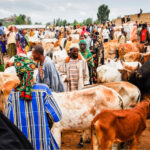Across Nigeria, agriculture is having a moment. A growing number of youths are returning to farmwork and agro-based enterprises. States are beginning to see agriculture as a viable path to wealth creation, food security, and youth employment.
At the Uyo Township Square, in Akwa Ibom, the state governor, Umo Eno, disbursed ₦492 million to 1,187 youths to support their ventures in farming, trade, and small-scale enterprises.
The breakdown showed 276 beneficiaries under the ARISE Farmers grant, 628 under ARISE Traders, 263 through the ARISE Equipment support scheme, 8 recipients of ₦5 million MSME grants, and 12 others who received cars and minibuses to power their businesses.
Beneficiary selection was powered by the ARISE Youth Employment portal, and the event doubled as a constituency meeting to receive a needs document for inclusion in the 2026 People’s Budget.
The Akwa Ibom government also highlighted that this administration has delivered 116 projects across the constituency in two years.
Official labour data show youth unemployment and underemployment remain a core problem for Nigeria’s development. Recent NLFS figures and independent surveys point to persistently high youth joblessness and sizeable shares of young people not in employment, education or training.
Targeted grants and skills support are therefore vital to turn potential into productive work.
When young people lack stable livelihoods, the fallout is broad: it raises the risk of social unrest, pushes talent into precarious informal jobs, and creates fertile ground for criminality and cybercrime as alternative income sources.
Studies and regional reporting link economic exclusion among youths to higher social fragility, making job-focused empowerment both a security and development priority.
For individual recipients the immediate effect is tangible; working capital, tools, transport and equipment can turn ideas into income overnight. Small grants and equipment reduce start-up friction (rent, inventory, transport), help stabilise cash flow, and improve the survival chances of microbusinesses.
That matters because MSMEs are the backbone of Nigeria’s economy: surveys and national reports place the sector as contributing roughly 48% of GDP and accounting for the lion’s share of businesses and jobs.
Strengthening micro and small enterprises through targeted grants can thus ripple out to sustained employment and local demand.
The governor’s mix of digital and physical channels – online enrolment via the ARISE portal, a public Town Square disbursement for visibility and accountability, and direct handover of equipment and vehicles on site – is commendable.
If sustained and scaled, followed with training, market linkages and monitoring, what started as an injection of cash and kit could seed resilient micro-industries across Uyo, expand value chains, and turn beneficiaries into employers themselves.
The next thing to watch is whether similar rollouts reach other constituencies and how the 2026 People’s Budget absorbs these grassroots priorities.
The impacts of this model are far-reaching: a stronger local economy, reduced youth restiveness, and a steady boost to food security.
However, barriers remain: without continuous training, market access, and proper monitoring, many beneficiaries may struggle to scale or sustain their ventures. Rising production costs, limited storage infrastructure, and fluctuating market prices could also erode the gains if not addressed alongside the grant disbursement.
Agriculture is becoming increasingly important in Nigeria, with a focus on youth involvement and enterprise development. In Akwa Ibom, Governor Umo Eno distributed ₦492 million to 1,187 youths for farming, trade, and small-scale enterprises. The funds were allocated across various initiatives such as ARISE Farmers, Traders, and Equipment support schemes, MSME grants, and business vehicles. This initiative aims to address youth unemployment and underemployment, significant issues in Nigeria's development landscape.
MSMEs play a crucial role in Nigeria's economy, contributing approximately 48% to the GDP. The disbursement model includes online enrolment, public disbursement events, and direct support. However, for long-term success, ongoing training, market access, and monitoring are necessary. Potential challenges such as rising production costs, limited storage, and market volatility need addressing. If these measures are scaled and integrated into broader strategies, they could enhance local economies, improve youth employment, and strengthen food security.






